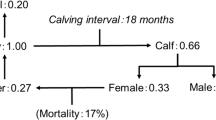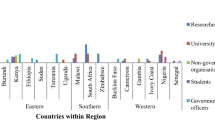Abstract
A survey was performed to characterize the dairy production, educational experiences, decision making practices, and income and expenses of dairy farms and to determine any differences of these practices among two dairy farm populations. Farm groups were identified as farms from the Muaklek dairy cooperative (Muaklek farms) and farms from other dairy cooperatives (Non-Muaklek farms). In April, 2006 questionnaires were distributed to 500 dairy farms located in Lopburi, Nakhon Ratchisima, and Saraburi provinces. A total of 85 farms completed and returned questionnaires. Means and frequencies were calculated for questions across categories and Chi-square tests were performed to determine differences among Muaklek and Non-Muaklek farms. Results showed that most farms from both groups had a primary or high school educational level, used a combination confinement and pasture production system, gave a mineral supplement, raised their own replacement females, milked approximately 16 cows/day, used crossbred Holstein cows (75% Holstein or more), and mated purebred Holstein sires to their cows. More Non-Muaklek farms (P < 0.05; 80%) used a combination of genetic and phenotypic information when selecting sires than Muaklek farms (54%). Monthly profit per lactating cow, were 1,641 and 1,029 baht for Muaklek and Non-Muaklek farms, respectively. Overall, information from the study should be useful for dairy cooperatives and other dairy organizations when training farmers in the future and furthering dairy production research in Thailand.






Similar content being viewed by others
Abbreviations
- EBV:
-
estimated breeding value
References
Chantalakhana, C., and Skunmun P., 2001. Dairy development in Thailand and a case study on environmental impacts of peri-urban dairy colonies, Part I. Smallholder dairy development. Ch. 12 in Smallholder dairy production and marketing - opportunities and constraints. Proceedings of a South –South workshop held at national dairy development board, Anand, India, 13–16 March 2001
Garcia, O., Hemme, T., Rojanasthien, S., and Younggad J., 2005. The economics of milk production in Chiang Mai, Thailand, with particular emphasis on small-scale producers, working paper, pro-poor livestock initiative, (Food and Agriculture Organization of the United Nations, Rome, Italy)
Leeuw, P.N. de, Omore, A., Staal, S. and Thorpe W., 1998. Dairy production systems in the tropics: A review, (International Livestock Research Institute, Nairobi, Kenya)
Likert, R, 1932. A Technique for the Measurement of Attitudes, Archives of Psychology 140: pp. 1–55
Losinger, W. C., and Heinrichs A.J., 1996. Dairy operation management practices and herd milk production, Journal of Dairy Science 79:506–514
Ministry of Agriculture and Cooperatives (MOAC), 2005. Thailand’s Dairy Industry Modernization,http://www.modernizethailand.com/conference/260149/data/agriculture/dairy.pdf
Nocek, J.E., Socha, M.T., and Tomlinson D.J., 2006. The effect of trace mineral fortification level and source on performance of dairy cattle, Journal of Dairy Science 89:2679–2693
Rhone, J.A., S. Koonawootrittriron, and Elzo M.A., 2007. Factors affecting milk yield, milk fat, bacterial score, and bulk tank somatic cell count of dairy farms in the Central region of Thailand, Tropical Animal Health and Production, Online First (DOI 10.1007/s11250-007-9074-5)
SAS, 2004. SAS 9.13 Help and documentation, (SAS Institute Inc., Cary, North Carolina)
Suzuki, A., 1998. The present situation of dairy farming in Thailand - a case study from the dairy farming development project in the central region of Thailand, Japan International Cooperation Agency, Technology and Development, 11, 66–74
Turongruang, D. and Demaine H., 2002. Participatory Development of Aquaculture Extension Materials and their Effectiveness in Transfer of Technology: the Case of the AIT Aqua Outreach Programme, Northeast Thailand. Ch. 22 in Rural Aquaculture, New York, CABI Publishing
Acknowledgements
The authors highly appreciate support from the Muaklek Dairy Cooperative Limited for their cooperation in this study and funding from the Kasetsart University Research and Development Institute (KURDI) under project code number K-S (D) 9.50. Other contributors to the study came from faculty and graduate students at Kasetsart University and the Dairy Farming Promotion Organization.
Author information
Authors and Affiliations
Corresponding author
Rights and permissions
About this article
Cite this article
Rhone, J.A., Koonawootrittriron, S. & Elzo, M.A. A survey of decision making practices, educational experiences, and economic performance of two dairy farm populations in Central Thailand. Trop Anim Health Prod 40, 475–482 (2008). https://doi.org/10.1007/s11250-007-9123-0
Received:
Accepted:
Published:
Issue Date:
DOI: https://doi.org/10.1007/s11250-007-9123-0




